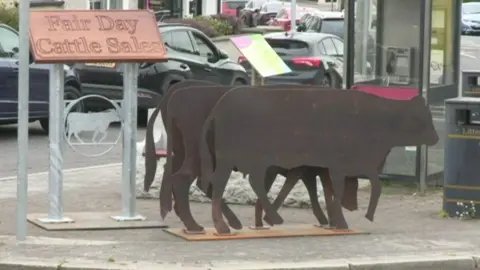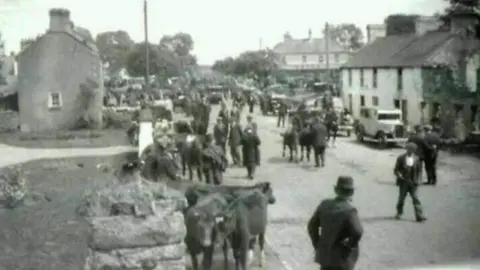Camlough: Sculptures tell story of south Armagh village's fair
 BBC
BBCIn May 1829, an advertisement appeared promoting a new monthly fair which would take place in the south Armagh village of Camlough.
The notice stated that because Camlough was situated close to Newry, in County Down, and "in the centre of a populous country, the fair is expected to be well supplied with all descriptions of stock".
Old photographs show a packed village centre with cattle, sheep and horses.
Today those sales have moved to more dedicated premises on the edge of the village - but a new set of metal sculptures have been installed in the village to tell the story of times gone by.
"We had three areas away back in the day for sales," Des Murphy, of Camlough Heritage Society, told BBC News NI.
 Camlough Heritage Society
Camlough Heritage Society"There were sheep sales in the commons, there were horse sales on the Quarter Road which was originally called the Horse Fair Road - and we've renamed it that - and we had the cattle sales in the main street."
Now, dotted across the village, you will see representations of these animals, built by local tradespeople and the Men's Shed.
The project was inspired by a photograph of man called "The Drover McShane", which for many years sat behind the bar of a local pub.
 Camlough Heritage Society
Camlough Heritage Society "He was arguably one of the best drovers in Ireland," said Mr Murphy.
"It was said that on a clear day you could hear the gulder (loud shout) of The Drover McShane coming around Camlough Lake, which was more than a mile away, him controlling his cattle.
"My uncle Joe would stand outside the pub with a pint of stout. The drover had no swallow. He'd drop the pint in two seconds, coppers were exchanged and the cattle didn't even had time to swish their tails as they passed through."
The sculptures aim to preserve local history - the sort not normally taught in schools.
Conor Sands is a history student at the nearby St Paul's High School.
He says the sculptures give his generation an understanding of life in the village in times gone by.
"This sort of thing isn't in history book - it isn't written down," he said.
"It's all oral history from grandparents and family friends.
"You take pride in saying that Camlough was the centre of this. It is so interesting to see that when you get up in the morning the places that you walk or drive past have a story.
"I never knew that this was once the Horse Fair Road."
"It's good to know what used to happen but doesn't happen any more, to know about the old traditions.
"We learn about worldwide things. You don't learn about the history of Camlough and Bessbrook, the old mills and businesses."
The question now is what from today will future generations look to remember in 200 years' time?
